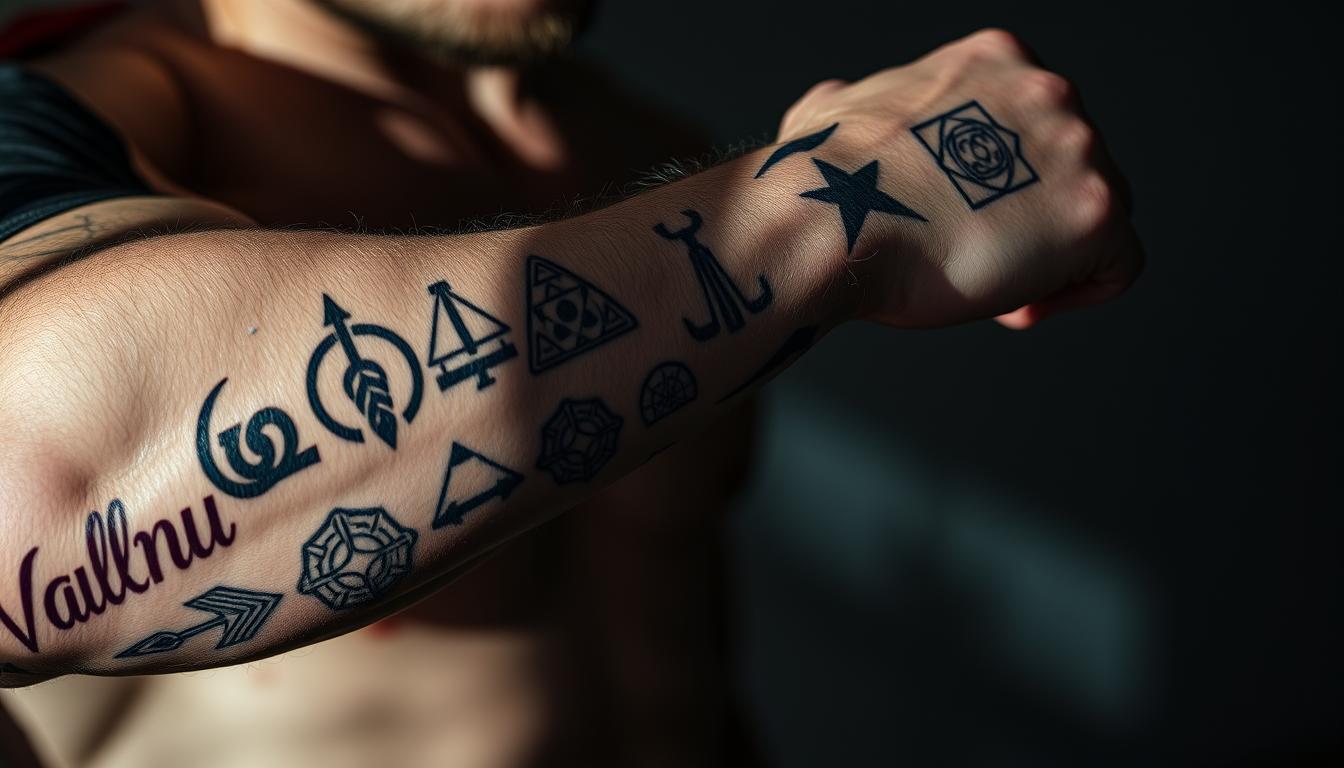
Imagine wearing art that connects you to warrior ancestors who shaped history through courage and exploration. Ancient Scandinavian cultures left behind symbols that still speak to modern seekers of identity and purpose. These designs aren’t just ink—they’re bridges to a time when every mark told a story of survival, honor, and connection to the divine.
Between 700-1100 AD, Norse farmers and traders became legendary seafarers. Pressured by limited resources and drawn to adventure, they navigated unknown waters. Though they left no written records, their legacy lives through artifacts and sagas. Today, their imagery resonates with those seeking depth in body art that goes beyond trends.
Each symbol served practical and spiritual roles. Warriors carried them for protection, while others used them to honor gods or mark life transitions. Contemporary designs blend historical accuracy with artistic interpretation, letting you choose pieces that align with personal values. Whether you’re drawn to intricate knotwork or bold mythological figures, understanding their origins adds layers of significance.
Key Takeaways
- Rooted in 8th-11th century Scandinavian culture
- Symbols served as spiritual armor and identity markers
- Modern adaptations balance tradition with personal expression
- Designs often reflect Norse mythology and natural elements
- Historical context enhances meaningful tattoo choices
Understanding Viking Culture and Its Tattoos
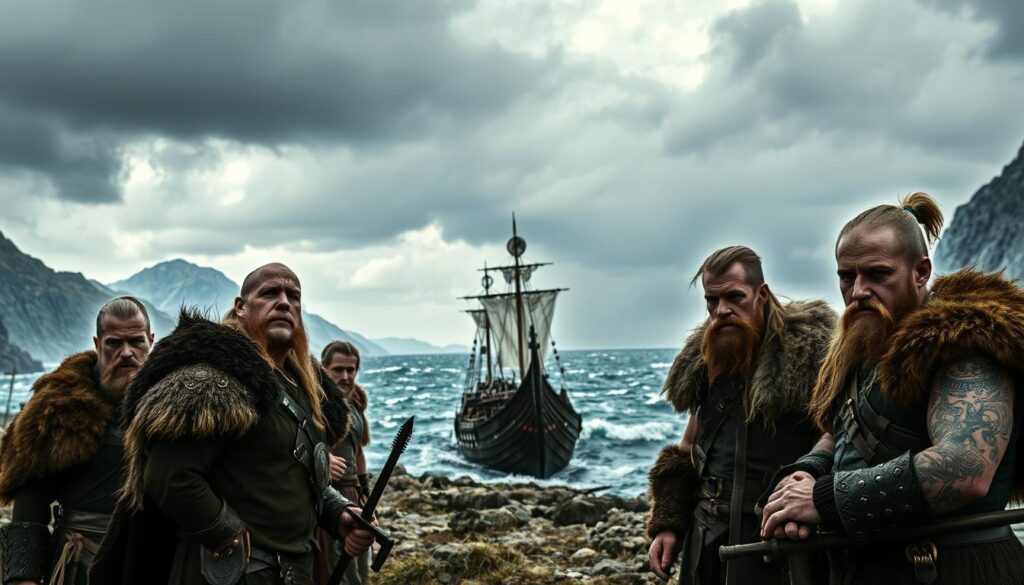
To grasp the symbols etched into modern skin, you must first step into the world of 8th-century Scandinavians. These weren’t just raiders in horned helmets—they were farmers who fed families, blacksmiths who forged tools, and storytellers who passed down wisdom through generations.
From Homesteads to High Seas
Coastal communities faced harsh winters and scarce land. Many turned to seasonal raids not for glory, but survival. Their iconic ships became floating platforms for both trade and conflict—swift enough to strike isolated towns yet sturdy enough to cross oceans.
Spiritual Armor in Ink
Norse spirituality saw gods walking among mortals. Symbols like Thor’s hammer weren’t just decorations—they were active defenses against misfortune. Today’s designs carry that same intent:
- Knotwork representing life’s interconnected paths
- Animal motifs channeling bear or wolf strength
- Runes invoking ancestral guidance
Choosing a symbol means aligning with values that outlasted empires. It’s not about reliving battles—it’s about carrying forward resilience shaped by frozen fjords and stormy seas.
Exploring Norse Mythology in Viking Tattoos
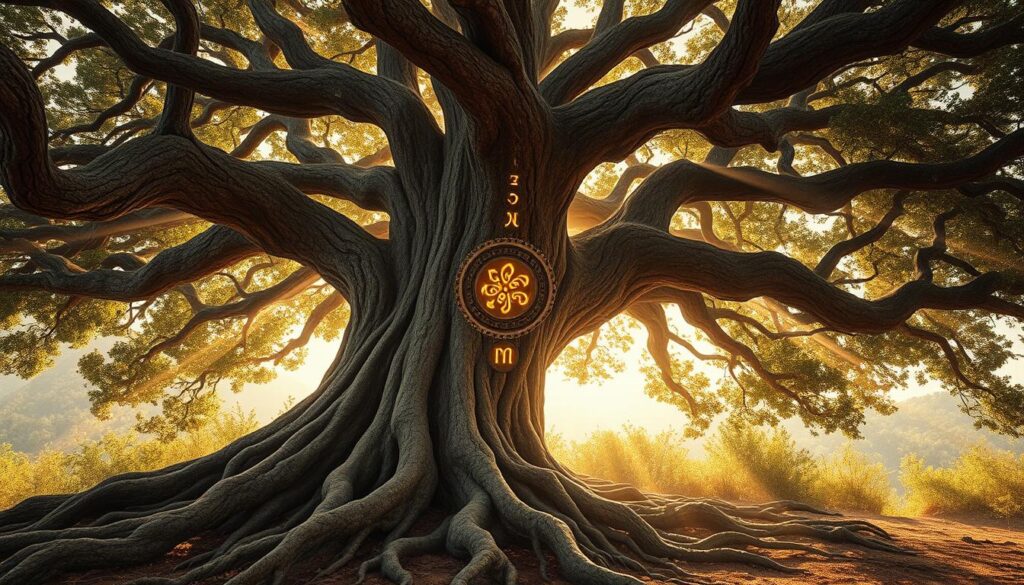
Your skin becomes a canvas for ancient legends when Norse mythology guides the needle. At the heart of this belief system stands Yggdrasil, the cosmic ash tree linking Nine Worlds through its roots and branches. From fiery Muspelheim to frost-covered Niflheim, each realm hosts beings that shaped Viking understanding of existence.
Key Gods and Goddesses
Odin’s single eye symbolizes sacrifice for wisdom, while Thor’s hammer embodies protection through strength. Freya’s necklace Brisingamen represents beauty intertwined with power—ideal for those valuing resilience and grace. These deities aren’t just characters; they’re archetypes reflecting human struggles and aspirations.
The Role of Mythical Creatures and Nature
Jormungandr encircling Midgard mirrors life’s cyclical challenges, perfect for wrapping around limbs. Fenrir’s unbreakable chains speak to confronting inner demons. Even Odin’s ravens, Huginn and Muninn, offer daily reminders to balance thought and memory.
Storms carved by Thor or oceans ruled by Njord transform natural forces into personal symbols. Yggdrasil’s sprawling form adapts beautifully across shoulders or backs, connecting wearers to the universal flow of energy. Whether you choose a coiled serpent or weathered oak, these designs root you in stories older than nations.
Popular Viking Tattoos for Men
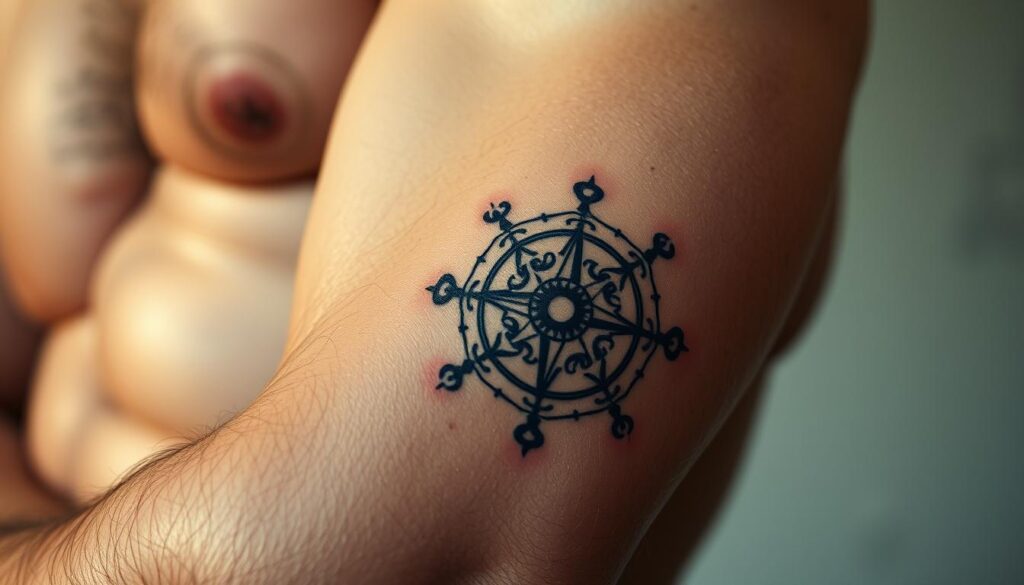
Body art steeped in Norse tradition carries more than aesthetic value—it’s armor for the soul. These timeless patterns speak to universal desires for strength and belonging. Let’s explore four iconic choices that dominate modern studios.
Helm of Awe and Valknut: Emblems of Protection
The Helm of Awe (Aegishjalmur) radiates eight spear-like arms from its core. Warriors painted it between their eyes before battles, trusting its geometry to shatter fear. Today, it’s a favorite for forearm or chest placements, channeling that same unyielding spirit.
Three interlocked triangles form the Valknut, often called “Odin’s knot.” This symbol marked fallen fighters chosen for Valhalla. Wearing it honors resilience—a reminder that true courage outlives physical struggles.
Thor Hammer and Yggdrasil: Symbols of Power
Mjölnir, Thor’s hammer, remains a top choice for its dual meaning. It represents thunderous force and benevolent protection. Artists often wrap it in storm clouds or Norse runes for added depth.
Yggdrasil’s sprawling branches adapt beautifully across backs or sleeves. This cosmic tree connects all realms, making it ideal for those valuing growth and interconnectedness. Pair it with animal spirits for layered storytelling.
| Symbol | Meaning | Best Placement | Style Flexibility |
|---|---|---|---|
| Helm of Awe | Invincibility | Forearm/Chest | Blackwork/Geometric |
| Valknut | Valhalla’s Gate | Shoulder/Neck | Minimalist/Detailed |
| Thor’s Hammer | Divine Strength | Upper Arm/Ribcage | Traditional/Realistic |
| Yggdrasil | Cosmic Unity | Back/Sleeve | Line Art/Watercolor |
Whether you choose one symbol or blend several, these designs transform skin into a canvas of legacy. They’re not just markings—they’re conversations with history that fit seamlessly into contemporary aesthetics.
Symbolism Behind Iconic Viking Designs
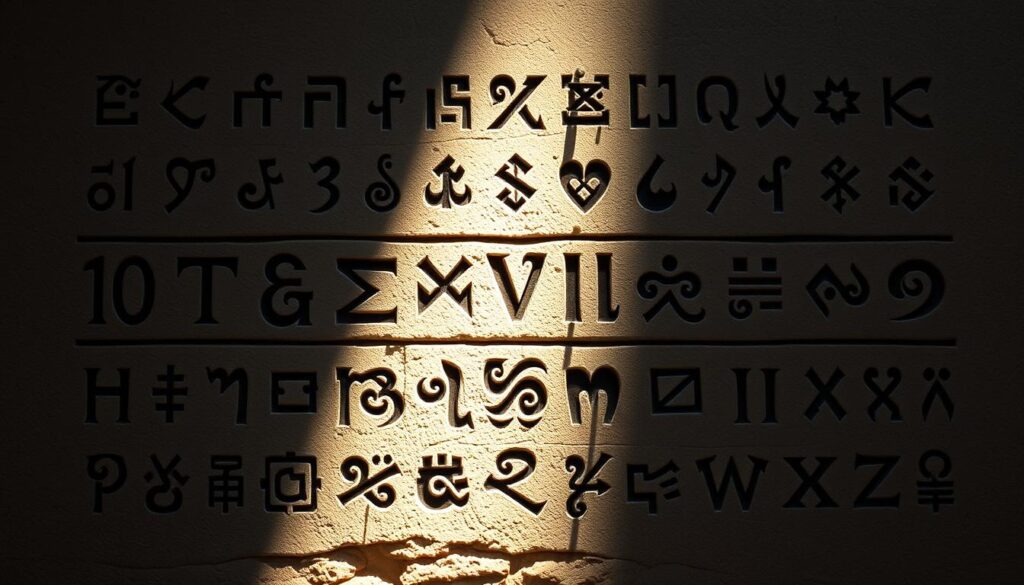
Every curve and line in Norse iconography holds hidden messages waiting to speak through your skin. These patterns aren’t random—they’re visual poetry from a culture that saw magic in everyday struggles. Let’s decode their secrets.
The Meanings of Runes and Ancient Alphabets
The Elder Futhark alphabet contains 24 characters, but Vikings rarely used them for letters. Each rune served as a direct hotline to divine forces. Fehu (ᚠ) called upon Freyr for abundance, while Uruz (ᚢ) channeled raw strength through Thor’s energy.
Consider these powerful examples:
- Algiz (ᛉ): Shaped like a standing person, it invoked protection during life’s storms
- Sowilo (ᛋ): Symbolized the sun’s unstoppable journey—perfect for overcoming obstacles
- Eihwaz (ᛇ): Linked to Yggdrasil’s wisdom, representing transformation through challenges
The Connection Between Tattoo Art and Norse Legends
Mythic symbols become personal guides when inked with intention. The Web of Wyrd isn’t just pretty knots—it’s a reminder that your choices ripple across time. As the Norns wove fate’s threads, so your decisions shape tomorrow’s patterns.
“What’s carved in flesh echoes in the halls of gods”
Yggdrasil’s roots dig deeper than aesthetics. Wearing this symbol declares your connection to nature’s endless cycles. The Ouroboros serpent biting its tail? That’s your daily nudge to embrace rebirth after life’s endings.
These designs map universal truths onto your body’s canvas. Whether you choose ravens for memory or wolves for pack loyalty, each mark becomes part of your evolving saga.
Tattoo Ideas Inspired by Norse Symbols
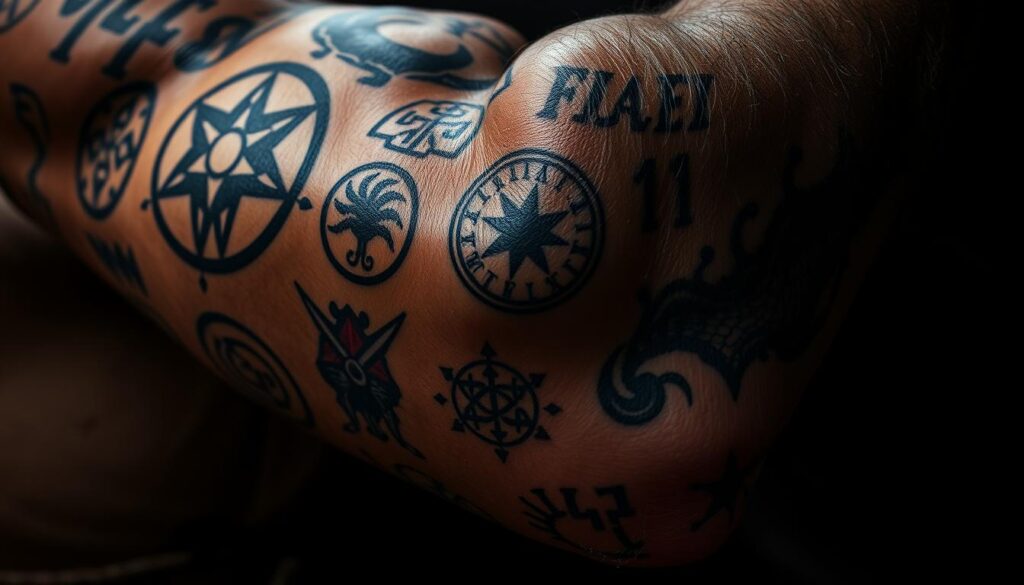
What if your ink could guide you through life’s storms? Three ancient symbols offer modern warriors tools for navigation and protection. The Vegvísir compass, Troll Cross, and Triple Horn of Odin adapt beautifully to contemporary body art while preserving their original power.
Unique Designs for Modern Warriors
The Vegvísir shines as a centerpiece for sleeve designs or chest pieces. Pair it with crashing waves or star constellations to emphasize life’s journey. Minimalist versions work well on wrists or behind ears for subtle guidance.
Want protection that fits your lifestyle? The Troll Cross integrates seamlessly into geometric patterns or nature scenes. Try nesting it within tree roots or mountain silhouettes for symbolic depth.
| Symbol | Modern Adaptation | Ideal Placement | Style Pairings |
|---|---|---|---|
| Vegvísir | Compass with coordinates | Forearm/Back | Realistic landscapes |
| Troll Cross | Geometric shield | Ribcage/Neck | Dotwork/Mandala |
| Triple Horn | Watercolor waves | Bicep/Thigh | Abstract brushstrokes |
Odin’s Triple Horn transforms beautifully when merged with mead-inspired textures or runic borders. Consider splitting the three horns across knuckles or fingers for a bold statement about wisdom through experience.
These designs grow with you. Start small with a single symbol, then expand into full-body narratives over time. Your artist can weave personal milestones into the patterns—a birthdate in runes here, a hometown coordinate there. The options mirror the endless paths of Yggdrasil itself.
Design Inspirations from Tattoo Artists
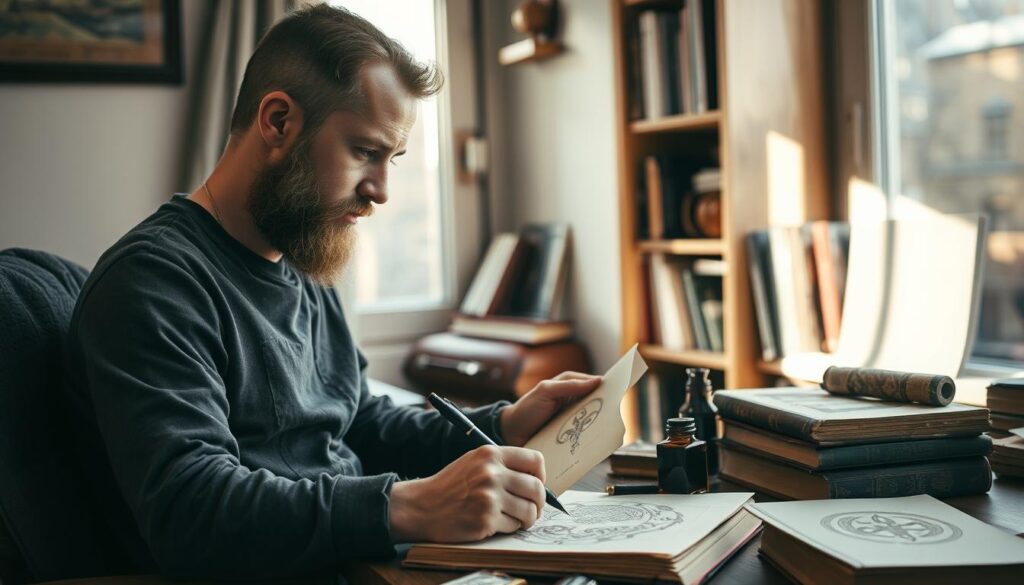
Your body becomes a living archive when skilled hands translate ancestral stories into modern art. Professional artists blend historical research with personal narratives to create pieces that resonate across time and culture.
Artist Insights from Piotr Szencel and Mark Gray
Piotr Szencel notices a striking difference in cultural approaches: “Nordic clients often bring family artifacts—a weathered arm ring sketch or part of a runestone rubbing.” He transformed one client’s museum-preserved Thor’s Hammer pendant into a chest piece, weaving the necklace’s patina into the design.
Mark Gray’s black-and-grey style breathes life into ancient symbols. His 35-hour sleeve project incorporated runes from the Codex Runicus, blending 14th-century law texts with flowing organic elements. “People want depth,” he explains. “They’re drawn to Norse imagery as a bridge between environmental awareness and spiritual roots.”
How Personal History Shapes Each Piece
Three elements transform generic patterns into meaningful art:
- Family heirlooms reimagined as tattoo motifs
- Historical documents like sagas or legal codes
- Natural textures reflecting local landscapes
Szencel recalls a client who embedded coordinates of his ancestral Norwegian fjord into a back piece. Gray often incorporates birch bark patterns—a nod to Scandinavia’s forests—into border designs.
These artists prove that authenticity comes from heart, not just historical accuracy. Whether you choose a minimalist rune or sprawling Yggdrasil, your skin can tell stories that outlive empires.
Norse Legends: The Stories Behind the Symbols
Ancient symbols carry stories that shaped entire civilizations. These patterns whisper tales of cosmic balance and mortal struggles, offering timeless lessons for those who listen. Let’s explore how age-old myths still guide personal journeys today.
The Nine Worlds and the Tree of Life
Yggdrasil’s roots dig into realms where gods clash and giants scheme. Asgard’s golden halls host Odin’s council, while Midgard’s forests shelter humanity. Niflheim’s icy mists and Muspelheim’s fiery plains remind us that opposites create harmony.
This cosmic tree isn’t just scenery—it’s the ultimate connection. Its branches cradle elf kingdoms and dwarf forges, showing how all life intertwines. Even Hel’s shadowy realm plays its part, teaching that endings birth new beginnings.
Epic Tales and Their Modern Interpretations
Odin’s ravens, Huginn and Muninn, now soar as symbols of mindfulness. Their daily flight mirrors your need to balance thought and memory. Thor’s battles against chaos become metaphors for overcoming daily struggles with unyielding strength.
Modern designs reimagine these legends. A Valknut’s three triangles might frame family initials, weaving personal history into Odin’s warrior code. Yggdrasil’s bark could twist into your hometown’s coordinates—a reminder that every journey starts at home.
These stories aren’t frozen in time. They evolve with you, offering wisdom for life’s endless raids against doubt. Wear them not as relics, but as living maps for your unique path.
